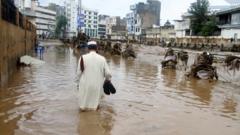Heavy monsoon rains have led to severe flooding and landslides in Pakistan, particularly in the mountainous Khyber Pakhtunkhwa province, where the death toll has tragically reached at least 307. The rains, expected to continue until August 21, have caused significant destruction, damaging at least 74 homes and leading to the crash of a rescue helicopter that resulted in the death of its five crew members.
The catastrophic effects of the floods have extended into Pakistan-administered Kashmir, where nine deaths were reported, along with five fatalities in the northern Gilgit-Baltistan region. Eyewitness accounts reveal stories of terror, such as that of survivor Azizullah, who described the moment the floods surged as like "doomsday," with the ground shaking violently beneath him.
Authorities have declared several areas disaster zones due to the ongoing severe weather. In Buner, local grief was palpable as people gathered for funerals near the site of destruction. Khyber Pakhtunkhwa's chief minister, Ali Amin Gadapur, confirmed the tragic crash of the M-17 helicopter amid adverse weather conditions while responding to the disaster.
The situation in Indian-administered Kashmir worsened as rescuers discovered bodies following a flood that devastated a Himalayan village, with initial reports indicating at least 60 casualties there. This season's monsoon rains have already seen 650 fatalities, intensifying fears among communities used to the risks associated with this time of year, characterized by extreme weather exacerbated by climate change.
In July, Pakistan's Punjab province experienced alarming rainfall levels—73% more than in the previous year—leading to more deaths than previously recorded during monsoon seasons. Climate scientists emphasize that ongoing global warming effects have rendered weather events more extreme, with glacial retreats in northern Pakistan contributing to increased vulnerability to such disasters.





















